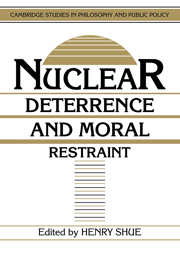Book contents
- Frontmatter
- Contents
- Preface
- Notes on contributors
- Introduction
- 1 Having it both ways: the gradual wrong turn in American strategy
- 2 Finite counterforce
- 3 Deterrence and the moral use of nuclear weapons
- 4 Escaping from the bomb: immoral deterrence and the problem of extrication
- 5 The necessary moral hypocriy of the slide into mutual assured destruction
- 6 Finite deterrence
- 7 Defending Europe: toward a stable conventional deterrent
- 8 The case for deploying strategic defenses
- 9 Morality, the SDI, and limited nuclear war
- Index
2 - Finite counterforce
Published online by Cambridge University Press: 26 January 2010
- Frontmatter
- Contents
- Preface
- Notes on contributors
- Introduction
- 1 Having it both ways: the gradual wrong turn in American strategy
- 2 Finite counterforce
- 3 Deterrence and the moral use of nuclear weapons
- 4 Escaping from the bomb: immoral deterrence and the problem of extrication
- 5 The necessary moral hypocriy of the slide into mutual assured destruction
- 6 Finite deterrence
- 7 Defending Europe: toward a stable conventional deterrent
- 8 The case for deploying strategic defenses
- 9 Morality, the SDI, and limited nuclear war
- Index
Summary
INTRODUCTION
When theoreticians like ourselves think about nuclear deterrence, often we focus on a nasty choice between two rival package deals. The two have gone by various names over the years, but let me take the paired epithets: It's MAD versus NUTS. Each package is a bundle of policies: centrally, policies for the procurement of strategic nuclear forces, conditional intentions about how to use those forces in case of war, war plans, declaratory policy. Each package also carries implications about military research and development, arms control, conventional preparedness, relations with our allies, and foreign policy generally.
In a debate between MAD and NUTS, each side may say that the other's policies involve a twofold risk: a grave moral risk of committing massacres and a grave prudential risk of inviting and undergoing like massacres.2 If they say so, they are right: Both MAD and NUTS are morally questionable, to put it mildly, and imprudent as well. (Imprudence is itself immoral, if it is the imprudence of a statesman who bungles the task of protecting his countrymen.) The contest between these two repugnant alternatives gives nuclear deterrence itself a bad name, and winds up making a strong case for a third package deal: nuclear pacifism, renunciation of all the risks and all the benefits of nuclear deterrence. Of course this third package carries its own grave moral and prudential risks.
No alternative looks good. How does the very idea of nuclear deterrence turn into the nasty choice between MAD and NUTS? Does it have to happen? Is there no way around it?
It happened for a reason, to be sure.
- Type
- Chapter
- Information
- Nuclear Deterrence and Moral RestraintCritical Choices for American Strategy, pp. 51 - 114Publisher: Cambridge University PressPrint publication year: 1989
- 5
- Cited by



